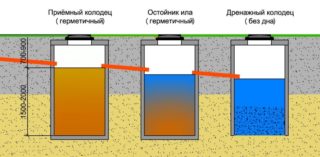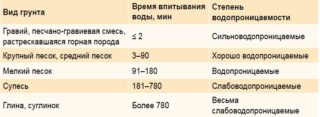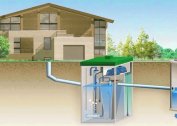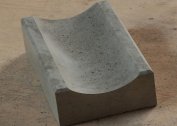Country cottages are usually located in areas where there is no centralized water supply and sewerage. During your stay, you need to somehow organize the pumping of wastewater. The optimal solution would be a self-contained sewer device for summer houses. This work does not require special knowledge in the field of engineering, but some rules still need to be observed in order not to encounter stagnation of water in the bathroom or flooding of the area with fecal matter.
Types of sewerage for a summer residence
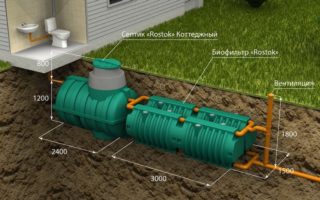 Suburban sewerage for a summer cottage can be equipped in several ways. It all depends on how much time people plan to live in the house - permanently or only in the summer, as well as how many people will use the cesspool.
Suburban sewerage for a summer cottage can be equipped in several ways. It all depends on how much time people plan to live in the house - permanently or only in the summer, as well as how many people will use the cesspool.
You will have to choose between the degree of purification and the cost, so some methods are more profitable to do with the joint efforts of residents of several houses or even the whole village.
Biological station
A deep biological treatment plant is an environmentally friendly method of wastewater treatment. The principle of operation is associated with the activity of microorganisms that process organic waste. With additional aeration, the liquid purity reaches 98%. It is possible to make a sewer in the country without a smell and pumping out, using only this method.
How does the system work:
- Drains from the toilet enter the preliminary chamber of the drain well, where they are cleaned of large particles and fat.
- The pre-purified liquid is treated with aerobic microorganisms, which are less sensitive to various chemicals used for washing dishes and washing.
- Large particles are processed by anaerobic bacteria and can be used as fertilizers for the garden.
- The purified liquid enters the perforated pipe and is absorbed into the soil.
The intensity of the water will be absorbed by the quality of the soil in the area. On sandy soils, more than 5 cubic meters of water are consumed per hour. On clay, it is practically not absorbed, so they use mechanical filters, after which the liquid is discharged into the nearest body of water. Water is odorless and completely safe.
The disadvantages of VOCs are:
- high price;
- installation complexity;
- the need to separate the drains, since the use of detergents can reduce the number of beneficial bacteria;
- dependence on electricity (some models), since various chopper devices, controllers, monitors, pumps are mounted in the circuit to accelerate the flow of fluid.
In addition to the station itself, it is necessary to construct filtration fields - areas where the surface layer of soil is separated by geotextiles, then there is a layer of rubble and sand, which filter the runoff before entering the soil.
When arranging a biological treatment plant, there is no need to remove waste, the sumps are cleaned once every 6 months or once a year, depending on how much septic tank is installed.
Septic tanks
These are two or three chamber devices for collecting and treating wastewater. It can be made of any material - brick, concrete rings, metal pipes of large diameter. On sale there are special plastic or fiberglass canisters designed to equip autonomous country sewerage.
Principle of operation:
- Drains by gravity fall into the first sump, where large particles settle to the bottom.
- In the first sump, aerobic bacteria come into play, which need air to live. They recycle organic matter, making it about 80% cleaner.
- As water accumulates, it flows into the second tank.There are two options: either it is leaky and the effluent goes into the ground, or through the pipe the liquid is diverted to the filtration fields. For example - in the garden.
The difference between a septic tank and VOCs is that the movement of water is carried out without electricity - using the slope of the sewer pipes and the difference in tank levels.
When installing a septic tank, you must follow the rules so that process water does not get into the drinking well. For this, before the construction of the sewage system, a project is being made where the location of the septic tank and the drinking well is planned, based on sanitary standards.
The rules for the location of the septic tank are needed not to please sanitation, but not to drink water with pathogenic microorganisms living in sewage.
Storage tank
 This is a cheaper type of sewerage for giving non-permanent residence. The principle of operation is that all wastewater is collected in a designated place, then taken out with a scavenger machine. During the summer, once you have to pump out the drains, which also costs money.
This is a cheaper type of sewerage for giving non-permanent residence. The principle of operation is that all wastewater is collected in a designated place, then taken out with a scavenger machine. During the summer, once you have to pump out the drains, which also costs money.
If the volume of a single-chamber septic tank is large, and a couple of people live in the house, then it can accumulate 2 to 3 years. However, an unpleasant smell appears near the pit, which in calm weather spreads around the district within a kilometer radius. This causes trouble for both residents and neighbors. In this case, it is necessary to regularly use special bacterial concentrates to destroy the smell. Within 2 to 3 days, the accumulation tank ceases to stench.
It is desirable to make this type of sewerage for a summer residence not to pollute the environment.
Cesspool
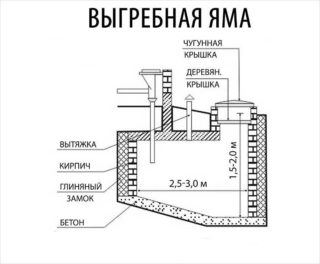 The simplest type of sewage system. It is done mainly for street toilets, which do not get chemical waste after washing and washing dishes. On the one hand, this is an advantage, since with the help of bacteria, fecal effluents can be turned into a full-fledged organic fertilizer. This will reduce the cost of farming and increase the yield.
The simplest type of sewage system. It is done mainly for street toilets, which do not get chemical waste after washing and washing dishes. On the one hand, this is an advantage, since with the help of bacteria, fecal effluents can be turned into a full-fledged organic fertilizer. This will reduce the cost of farming and increase the yield.
Cons of the cesspool at the cottage:
- it must be cleaned periodically (even waste processed by bacteria must be unloaded into the garden);
- the impossibility of complete cleaning, since the pit is usually made with an open bottom;
- if the groundwater is high, it can cause a hole in the pit and bacteria to enter the drinking water.
When arranging this type of country sewerage, compliance with safe distances between the toilet and the drinking water well is required. It is better if they are located at different ends of the site.
The cesspool can be made airtight, periodically pump out the waste and take it out for disposal. This is a safer, greener method, but requires extra cash.
The main criteria for choosing a country sewerage
If there is a household appliance in the country house - a washing machine or a dishwasher - the chemicals will fall into the drains. This will make it almost impossible for bacteria that decompose organic matter. It is advisable to make the structure airtight.
The work of autonomous sewage in the country depends on the quality of the soil. An open bottom septic tank is most often made on sandstones, where water is better absorbed into the soil. In clay, it is better to make sealed two-chamber septic tanks so that completely purified water can be diverted into a common ditch or pond, while not harming the environment.
A cesspool without a bottom is equipped if the daily volume of effluents does not exceed 1 cubic meter and it is possible to carry it at least 50 m from the source of drinking water. A pit in which the walls are not flooded with concrete will have to be closed sooner or later. After a while, usually 10 - 12 years, the walls cease to absorb water and the septic tank overflows. If you add sedimentary runoff here, you can fill the area with feces and spoil your stay in the country.
The well volume is calculated based on the number of residents and the time that people will spend in the country.
The most optimal option is a sealed plastic container from which waste will be periodically taken out, or a two-chamber container in which it is possible to clean the drains with bacteria. It costs a little more, but you can be calm about drinking water on your site, as well as rely on organic fertilizers for the garden.
Design and implementation of necessary calculations
 The calculations are as follows:
The calculations are as follows:
- Determine how many materials will be required to install the sewer. This includes internal wiring and external communications.
- Correctly design the laying of the inner pipes and the main riser, calculate the volume of effluents based on the number of residents, choose the diameter of the pipes correctly.
- Determine the location of the drain well or two - depending on what type of septic tank is selected. Calculate the length and slope of the pipes to the septic tank.
You can start installation work when there is an exact plan of what is located and all types of pipes and fittings are purchased.
Installation Steps
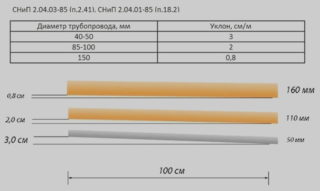 First, plumbing is installed and the internal pipes are routed, which is discharged through a common riser to the external pipe.
First, plumbing is installed and the internal pipes are routed, which is discharged through a common riser to the external pipe.
Next, markup of external communications is done, based on the plan. Trenches are being prepared for laying pipes, taking into account the necessary slope towards the well:
- for pipes with a diameter of 50 mm - 3 cm per linear meter;
- 110 mm - 2 cm;
- 150 mm - 1 cm.
Depth is determined by the degree of soil freezing in winter. Sometimes the pipes are insulated with special material and wrapped with tape.
Next, excavation work begins - digging trenches and pits for the septic tank. If the walls are planned to be concreted, then you need to do this in dry weather and allow the solution to completely dry. After that, pipes are laid, connected to a septic tank and the system is tested with a stream of water. If everything works well and the liquid does not stagnate in the plumbing, the trenches are first covered with sand, then with earth and rammed.
The most expensive country sewerage systems are volatile local treatment facilities. Two-chamber environmentally friendly sealed septic tanks with a gravity system are cheaper. Even cheaper - a sealed cesspool with common drains from all plumbing and household appliances. An ordinary leaky pit is prohibited by law, therefore this type of sewage is not recommended for installation because of the high risk of pathogenic microbes getting into the ground and drinking water.
